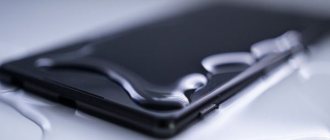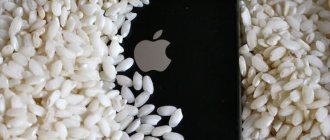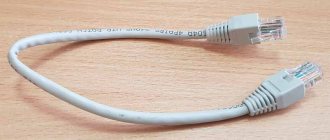One of the worst nightmares of a modern person, whose whole life is “stored” in his phone, is the device falling into water. If you dropped your smartphone in the bathroom, washed it with your clothes, or just got caught in the rain - it doesn’t matter. The result is always the same: the mobile phone breaks down or stops working properly. However, it’s too early to despair: here’s an action plan for preserving and bringing your phone back to life. It won't always work, but it's definitely worth a try.
What to do if Honor or Huawei falls into water
The first recommendation that needs to be given here is to take the device to specialists. But if this is not possible, you have to repair the gadget yourself.
Remove the smartphone from the water, turn it off and disassemble it
First, remove your phone from the water and quickly turn it off. After getting wet with a dry towel, you need to remove the SIM card and memory card. We emphasize that you cannot try to disassemble it or even remove the battery if the cover is not removable.
If the phone is not separable
If the back cover of the device is removable, then remove it and remove the battery. Independent attempts to disassemble the smartphone will lead to complete inability to restore it.
What not to do after water gets into your phone
There are actions that harm your device. Among them there are those that are constantly recommended by craftsmen, such as a hair dryer or a vacuum cleaner. Few people know, but such methods will only harm the gadget and leave it in a condition beyond repair. Also, immediately after disassembling, do not try to turn on the device if it is turned off. To start, you need contact between the internal microcircuits, which are now wet.
Sensor repair
If after drying the device the sensor still does not work, it is better to take the gadget to a professional service.
If you wish, you can try to change the part yourself, following the instructions:
- We clear the workspace, place a small box on the table, where various bolts will subsequently be placed.
- Remove the front and back panels, unscrew the bolts in the battery compartment.
- We unscrew the two screws located at the top of the device, turn off the screen connector, disconnecting the cable from the microcircuits.
- Separate the board from the screen. Using a washing eraser, clean the contacts of the cable until shiny.
- We check the connection between the sensor and the cable by placing an eraser between them. If there is contact, then the problem is not with him.
- We remove the old module and install the new one.
- We carry out all the steps in reverse order, excluding step 5.
Replacing a sensor is a complex procedure that requires not only skills, but also time, since everything can take several hours. If the problem is not solved, it is better not to aggravate it and take the device to a specialist.
Absorbent or rice
Rice or a substance that absorbs water is a more effective method to remove moisture particles from the device. To begin with, we remove the excess liquid with a towel and blot thoroughly. It is impossible to remove all the drops with this method, so it is recommended to leave the phone in a bowl of rice. This cereal requires a lot of liquid, so in a few hours it will take away all the remaining moisture.
Absorb moisture using absorbents
An absorbent is a substance that can absorb water in a short period of time. To speed up the drying process of your phone, you can use the following types of absorbents:
- Place the phone and its battery in a bag of rice. Leave the device in the cereal for several days, turning it over periodically so that the water is better absorbed. Rice draws out liquid well, so it can slow down corrosion.
- You can use silica gel balls, which are usually included in shoe boxes. They absorb moisture better than rice, so their use time is slightly reduced.
- Cat litter is also suitable for this purpose. The principle of operation is the same: put the phone and its battery in a bag or container with filler and leave for 2-3 days. The product should completely cover the device.
Don’t forget to periodically check your smartphone and remove moisture from its surface using paper napkins. You cannot turn it on - we are talking about drops of moisture on the case. If necessary, replace the absorbent with a new one.
For additional effect, you can place the phone in the sun or a warm radiator.
Attention: the method with the sun or radiator is suitable only for owners of gadgets with a removable battery. Remove it and put just the phone body to dry in a warm place. Failure to do so may cause the battery to explode.
The main problems when water gets into a smartphone
The most difficult problem is the shorting of contacts, which will then need to be changed. If moisture gets on the modules in small quantities, then there is a chance that after drying it will function normally. If you tried to turn it on wet, then the risk of burnout increases by 96%.
It is also strictly forbidden to charge a wet or damp device. The risk ranges from short circuit to fire.
After contact with moisture, the phone may function normally, but some of its elements often stop working. The most vulnerable are the speaker, microphone and battery. Almost always, after serious wetness, they require cleaning or replacement.
Vacuum cleaner to the rescue
You can try blowing out the water with a vacuum cleaner. Don't put your phone too close to the vacuum hose. This creates static electricity, which negatively affects the operation of the device. Each part is purged for approximately 15-20 minutes. Under no circumstances use a hair dryer for these purposes, even on a gentle setting and at low speed. In this way, the water does not dry out, but penetrates even deeper, and this is dangerous for the electronic parts of the phone. Additionally, you can melt some parts.
What to do after drying
It seems to many that after a good drying, the phone is immediately ready to rush into battle. But this is not the case, since the owner will have to check all the functions of the device before celebrating the victory.
After a few hours, make sure the device is dry. Hold the power button until the smartphone turns on. If the battery has run out, connect the power adapter to the device and wait until the power is fully restored.
Turning on a musical composition will help you find out if there is any moisture left inside. A wheezing speaker is direct evidence that the smartphone is not dry.
If your device's speaker wheezes, turn off your smartphone immediately. Give it a few more hours to dry. Better yet, wait until the next day.
Then you need to test wireless interfaces like Bluetooth, WiFi and NFC, as well as the mobile network by making a call. Along the way, pay attention to how the smartphone reacts to certain actions. Periodic lags and crashes from applications will indicate that the device has malfunctioned under the influence of moisture.
You can fix the instability of the gadget by resetting it to factory settings. The operation will delete data, but if you create a backup copy, losses will be avoided.
Open your smartphone's settings and go to the recovery and reset section. Click the appropriate button to delete all data. After completing the operation, the device will reboot and may begin to work more stably.
What to do if the phone does not turn on
It is possible that even careful drying will not lead to the desired result. For example, the smartphone will not want to turn on. In such a situation, you can check the functionality by switching to recovery mode. Hold one of the volume rockers and the power button.
An English-language menu will appear on the screen, which indicates the functionality of the gadget. But you should reset the settings by pressing the “wipe data/factory reset” button so that the smartphone can finally turn on.
If none of the recommendations help, you will need to contact a service center. Specialists will diagnose the device and determine whether it can still be restored.
Water getting on a smartphone is not a warranty case, even in a situation where the manufacturer claims water protection.
If all else fails
Even though the material provides detailed instructions on how to restore a drowned smartphone, the likelihood of an unfavorable outcome is high. Therefore, it would be a good idea to consider an action plan in case all else fails.
Hermann
Expert in the field of digital technologies and the activities of mobile operators. I am engaged in constant monitoring of industry changes in Russia and abroad.
Ask a Question
Question to the expert
What determines the success of the operation?
From many factors. And here it will be important not only to follow all recommendations. The likelihood of recovery is directly affected by how long the smartphone was under water and whether it came into contact with a more aggressive liquid.
Does IP67 or IP68 protection help?
Not really. The protection standard is provided for fresh and cold water only. No contact with juice, coffee or salt water is implied.
What to do if the phone does not want to turn on after drying?
Make sure the device body is completely dry. Then put your smartphone on charge and wait until the coveted 100% lights up on the screen. If the device still does not start, perform a factory reset through the recovery menu by pressing one of the volume rockers and the power button.
Do I need to disassemble my smartphone if all else fails?
With the right level of skill, this will really help solve the problem. Having disassembled the smartphone, you can assess the scale of the tragedy from the traces of oxidation.
Can a smartphone be restored at a service center?
Yes, but no one can give a 100% guarantee. The service center specialists will conduct diagnostics and offer several ways to solve the problem. The battery or other hardware may need to be replaced.
Is water penetration covered under warranty?
No. Even in a situation where the characteristics of the smartphone claim protection from water.
4.6 / 5 ( 22 voices)
0
Author
Hermann
Expert in the field of digital technologies and the activities of mobile operators. I am engaged in constant monitoring of industry changes in Russia and abroad.
Classic restart is the solution
Without going too far, restarting the mobile phone can solve our problem. When we constantly try to charge the mobile phone after getting wet, the humidity detection that phones have may be blocked, and we can only avoid it by restarting. When we turn it on again, we will believe that it can be charged.
Try Safe Mode
In case we have nothing to steal, we will have to resort to safe mode. This option is different on each smartphone, although in general we can use Android by pressing the payment button and then holding that button for a few seconds.
By enabling this mode listed below, we will only have to check if our mobile phone is charging now . The error may be due to the software and the moisture has actually disappeared, which makes this method to unlock it permanently.
Dry your mobile phone as best as possible
First of all, we should know that charging a wet mobile phone is a serious mistake, it leaves us without a mobile phone and also makes us take an important scare. Water and electric current may cause short circuit, before charging we should try to dry it completely so that there are no drops on the mobile phone.
Once you are sure that there is no more water left, you will only need to go to our charger and check if it is charging. In case this is not yet possible, the most convenient thing is to leave it at home in a dry place so that it finally removes all liquids by evaporation and assumes that the problem will not get any worse.
Hair dryer or vacuum cleaner
Most users immediately grab a hairdryer or vacuum cleaner. It is not recommended to blow out the device. The hair dryer produces a stream of hot air, which causes the electrical parts to overheat. Technical consultants recommend using the vacuum cleaner at minimum speed. It is needed to completely absorb drops of water. It is absolutely powerless in the fight against moisture inside.
Reboot your phone
From time to time, any software gets a glitch that disappears after rebooting the phone. It sounds corny, but take your Samsung Galaxy and reboot it. This can be done in a simple way: turn it off and turn it back on.
It often happens that the operating system does not understand whether there is moisture left in the USB port, and rebooting is an effective way to solve the problem.










